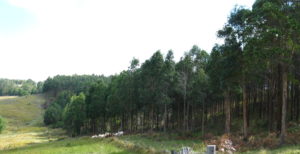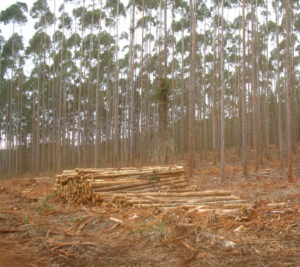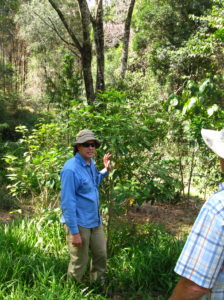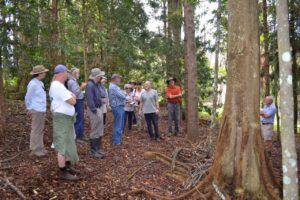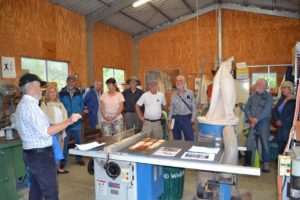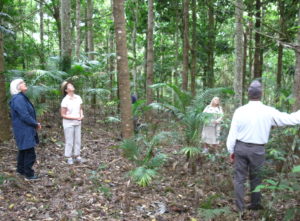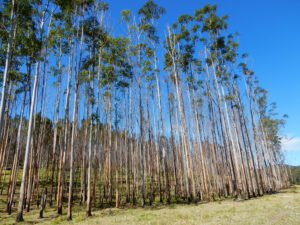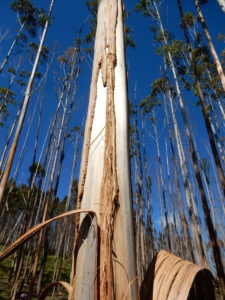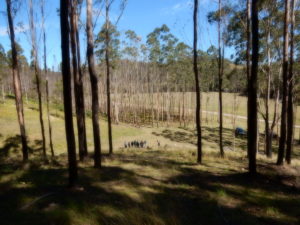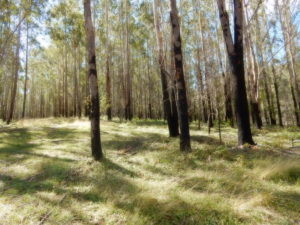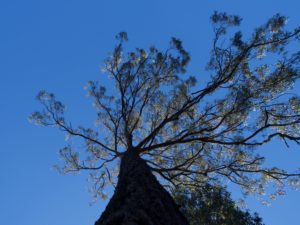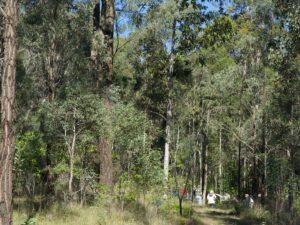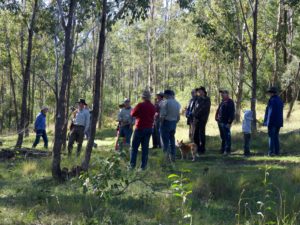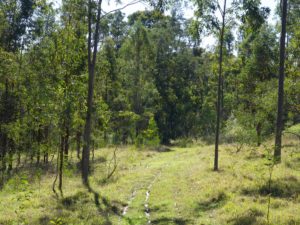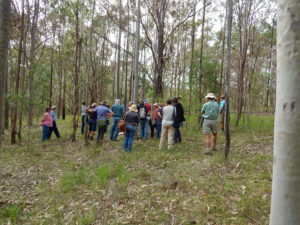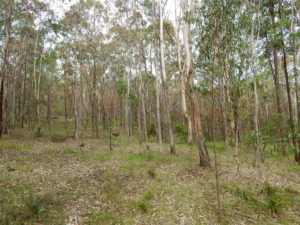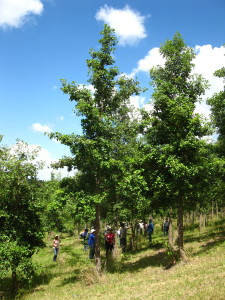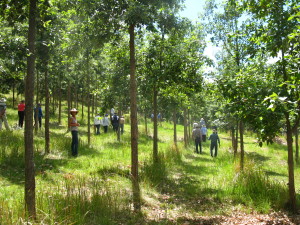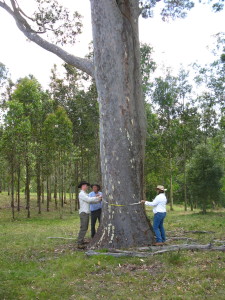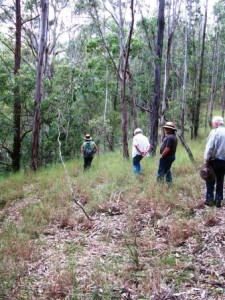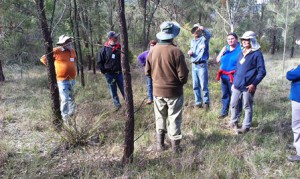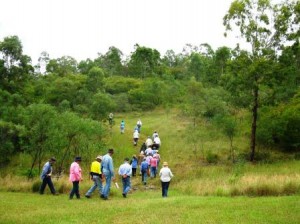North Coast Farm Forestry Trip October 2017
HFFN NSW NORTH COAST TRIP OCTOBER 2017
Lismore region
The NSW North Coast grows fantastic trees and once contained “The Big Scrub” rainforest.
HFFN member Brian Wright invited HFFN to visit, and 14 of us spent 4 days experiencing plantations, forests, researchers and nurseries in the area. We also enjoyed local farmstays, B&B’s and restaurants and invited north coast growers to visit HFFN.
Thanks to our hosts Brian and Mark Wright, Martin Novak, Joe Harvey-Jones, Doland Nichols and Mark Dunphy.
Hardwood Plantations, Cattle Grazing and Environmental plantings http://www.superforestplantations.com.au/
Members of the Wright family have several properties where they are planting eucalypts for durable timber, converting ex-joint-venture plantations into productive plantations, grazing cattle and establishing environmental plantings.
Over two full days Mark and Brian amazed us with the scale of their forestry, soil improvement, innovative planting methods and tree recording. They are developing new products and markets to suit plantation timber, and considering establishing milling and processing facilities.
1 Cattle grazing integrated with plantation eucalypts
2 Plantation thinning
3 Mark Wright and environmental plantings
The Subtropical Farm Forestry Association (SFFA)
The SFFA is a group similar to HFFN.
Martin Novak and Joe Harvey-Jones led us through rainforest plantings nearly 20 years old, towering overhead and forming a carpet of soft leaves with glistening blue fruits from the enormous Blue Quandong trees Elaeocarpus grandis. We talked about how to harvest some of the trees and keep the forest growing. They are promoting native tree plantations and ways for farmers to improve lands that have been taken over by Camphor Laurel Cinnamomum camphora
We discussed their Quality Timber Traders initiative which is linking smaller forest growers to markets. https://www.qualitytimbertraders.com/ and HFFN members were asked to register their interest https://www.qualitytimbertraders.com/eoi
4 Joe Harvey Jones yo rainforest planting
Southern Cross University Forest Research Centre http://scu.edu.au/forestresearch/
SCU has the most comprehensive forestry courses in Australia and are working closely with the Wrights and other local growers. They also work with overseas forests where research and development funding is often more available than in Australia.
As well as forestry courses, Doland Nichols invited us to further discussions about hosting research students in the HFFN area.
5 Doland Nichols at the SCU Forest Research Centre
Rocky Creek Dam Rainforest Plantings
The late Ralph Woodford pioneered rainforest establishment on degraded farmland on lands around the Rocky Creek Dam.
We were left speechless at the results of his work, which is available online
http://www.aabr.org.au/_upload/MemberPublications/WoodfordRockyCreekFeature.pdf
6 Rocky Creek Dam rainforest plantings
Firewheel Ecological Restoration and Rainforest Nursery
Mark Dunphy walked us through his specially built nursery at Durroughby http://www.firewheelnursery.com.au/. Many of the methods he uses were developed by the Wingham Brush project.
For many rainforest species they germinate seed when it’s available and keep the seedlings in trays until they are needed to grow on. This works for species that naturally sit as small plants on the forest floor until a storm opens up the forest canopy.
Mark has a wide range of plants and many of them overlap with the Hunter and Mid-Coast areas.
Field Day 27 August 2017
Ward’s River.
A very interesting day looking at a large commercial scale plantation established by the Forestry Commission on private land. The landholder has since taken over management of the plantation.
The establishment of the plantation included deep ripping, mounding, application of residual herbicides before planting a selection of species in large monoculture plots of Spotted Gum, Flooded Gum and Blackbutt. The appropriateness of the establishment practices and choice of species was the subject of extensive animated discussion.
Last summer a wild fire burnt a large proportion of the plantation. Many of the species survived quite well, but the flooded gum were severely damaged.
The Blackbutt survived the fire well
As usual, morning tea and lunch were convivial and a great social addition to the serious side of the day.
Thanks to our hosts, Denise and Geoff.
Field Day 25 June 2017
This field day was designed as introduction to tree growing and farm forestry and particularly focused on the new contacts established at Tocal field days. Subjects included trees growth, tree management, thinning regrowth and portable milling of thinnings.
25 people attended on a beautiful warm sunny winters day and as usual for a HFFN field day, morning tea was prolific and luscious and conversations and networking were in the same vein.
Simon gave an introduction to the property and his management aims. Trevor gave a very brief talk on tree defects, supported by the timber samples prepared for Tocal. Then a property walk. The property has some significant stands of big old growth iron bark, grey gum, grey box and forest red gum. There is also prolific regrowth of iron barks, box and gum species. Simon has been thinning and pruning the regrowth to promote tree growth and the quality of resultant timber, so there was much discussion on the value of the old trees and the growth habits and values of younger trees.
Lunch was a typical social event.
Several large trees which fell over during windstorms in 2015, have been milled to produce timber for furniture and other purposes. Simon gave a brief demonstration of the Lucas mill.
An enjoyable and sociable day, with much discussion on how to manage trees.
Objective achieved!
Tocal 2017
Wonderful weather, great people passing by and a lot of people expressing interest in farm forestry. We will be in contact with all those who expressed interest.
Thanks to all the people who manned the stand and in particular to Simon, Bron and Phil who worked together to get those new posters done. They are spectacular. 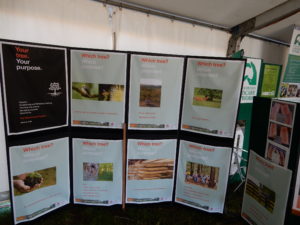
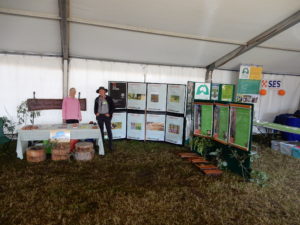
Thinning Field Day Monkerai April 2017
HFFN worked with the Local Land Services to run a field day on thinning regrowth Eucalypt forests. The day was well attended by an enthusiastic and friendly crowd, helped of course by some healthy and tasty catering from Anne, Judy and the LLS.
Judy’s property had been cleared and grazed until the 1970’s. Changes in property management then lead to steep rain forest gullies becoming overgrown with lantana and weeds and the drier slopes colonised by lantana and even aged regrowth of spotted gum, iron bark, grey box and grey gum .
In the last few years, large areas of lantana have been cleared and on the drier slopes, the sub dominant trees have been thinned using stem injection.
Presentations included description of local endangered flora and fauna by Bill Dowling and the implementation of the new biodiversity act by Nicki Cooper (LLS).
During a paddock walk, Annabel Kater (Australian Sustainable Timbers) explained tree physiology and Eucalypt growth habits. Thinning is being carried out to establish an uneven aged forest and to increase the biodiversity in the lower and mid storeys. Annabel explained the decision making process in choosing trees to thin and gave a demonstration of stem injection.
The afternoon session was a networking and chat walk while inspecting the rainforest tree plantings in the large rainforest gully now cleared of lantana and vines.
A great day. Thank you Judy, Anne and the LLS.
Mentoring Program
The HFFN Mentoring program helps landholders find their way. Experienced HFFN members visit landholders to discuss land management issues. The mentors aim to support landholders as they analyse problems and make decisions.
In 2016, the founder of the Master Tree Grower Programran three field days in various parts of the region which provided valuable lessons in farm forestry.
The mentoring program is continuing for 2017. Do you want an experienced farm forester to come and have a look at your property and help you find a way to decide which way to go? Contact secretary@hffn.org.au
Stanhope November 2016
Field Day and AGM November 2016 – Stanhope
An inspiring day which shows just what can be achieved through dedication and hard work. Phil and Heather have planted an extensive portion of their property. The excellent Turpentine plantation appears unique – no one else in the group had seen a Turpentine plantation elsewhere!
The property is located high on hills overlooking the hunter valley with a 1200mm rainfall, high winds and a climate very different from the valley floor.
Phil and Heather have developed planting techniques suitable for their topography and climate and are designing plantings to replace lost diversity. A feature of their work is meticulous planning, research and record keeping.
A few remaining old growth trees on the property are testament to what used to be. A unique property in a spectacular location, complete with a shady rotunda for the AGM.
Field Day October 2015
Our last field day was held at the property of Jane Richens and Brian Doherty, Tabbil Forest situated on the Bingleburra road. The property is over 600, and has a unique feature, 200 acres of dry temperate rainforest which amazingly has never been disturbed (logged). This is the largest undisturbed rainforest on private land in the region. Jane and Brian have owned the property for over 15 years, and did not realise the extent of the rainforest until after they had made the purchase. A PVP contract is in place for improving the biodiversity.
The topic of the day was Farming Endemic Diversity – basically looking at the rainforest and what management practices have been used to control weeds, in particular lantana. Lantana at the edge of the rainforest was allowed to remain to reduce the incursion of other weeds – lantana does not penetrate into well shaded areas. The pleasure of the day was increased by the weather – mild temperature, overcast (less UV), and with a small amount of rain (befitting a rainforest) during the lunch break when we were under cover. The field day was attended by over 20 members.
Jane and Brian have a grant to support their weed management efforts, using both the splatter gun (10% glyphosate) and manual removal for lantana. They have found that, while the splatter gun is very effective for dense infestations of lantana, for more sparse (and less leafy) bushes in dry sclerophyll forest conditions the splatter gun is less effective (requiring double concentration of glyphosate for a reasonable kill rate) and the manual removal is preferred.
In addition to seeing a section of rainforest, we were shown areas along the main creek through the property, which had been a raging torrent during the rain event which devastated Dungog. On the banks of the creek there were extensive areas of lantana and other weeds which were being treated chemically.
After lunch a large section of dry sclerophyll forest was inspected, in which the sparse clumps of lantana had been manually removed. Plants identified by Fred and Annabel were duly added to Jane’s species list.
Overall, it is fortunate that this property with its extensive rainforest is in good hands, and it was clear that the grant has enabled them to make good progress with weeds using their own labour.
During the day, Jane showed the group a few references that she uses to identify the species in the rainforest – an interactive key and a Dictionary of Botanical Names (the Blue Book).
‘Rainforest plants of Australia: Interactive identification key and information system Rockhampton to Victoria’; this has been created collaboratively between the people that put out the well-known ‘red’ book – Gwen Harden, Bill McDonald & John Williams – and the photographic books of Hugh and Nan Nicholson. It is available from Gwen Harden Publishing http://rainforests.net.au at a price of $80 (single user)
‘Dictionary of Botanical Names’ Australian plant names: meaning, derivation, & application’ – compiled & illustrated by Don Perrin, 22 Church St, Kippa Ring 4021, phone: 07 3284 7420. Don is not too keen on the digital age, but will respond promptly to a letter with an enclosed cheque for $15 (includes postage)
Field Day June 2015
The HFFN field day on 21st June 2015 at Martindale provided an opportunity for members to look at Trevor’s proposal to thin an area of regrowth of Casuarina (Allocasuarina luemannii, bull oak). It is a long lived aggressive western species that comes into the Upper Hunter. The regrowth is probably the result of two previous fires and the large number of Casuarinas is changing a Vulnerable Ecological Community. The area previously had grasslands containing terrestrial orchids which are listed as a threatened species in the Muswellbrook LGA. We walked through the area before work on thinning began and saw the magnitude of the problem. The HFFN consensus on how to thin or remove the trees included noting that poisoning of the trees could destroy the mycorrhiza fungi which will impact on the regrowth of orchids. Cutting and pasting the trees at hip height, purely mechanical removal and mulching them with a forestry mulcher were all canvassed. Carrying out pilot studies on small areas with different approaches, including poisoning was recommended.
The property has a 15 year old plantation of Eucalypts that has been pruned and thinned. Species include Slaty Gum, Forrest Red Gum, River Red Gum, White Box, Grey Gum and Iron Bark.
A general meeting held after lunch reported on future field days and potential funding from LLS for proposed mentors. The previous field day suggested that a course ‘An Introduction to Farm Forestry’ be held. As a result of the mentoring program this will not happen this year. Details of the field days and mentoring program will be put on the HFFN web site and emailed to members when the dates and details are confirmed.
Some members and Trevor discussing the issues amongst the Casuarinas
Field Day March 2015
The HFFN field day in March 2015 provided an opportunity to see what Simon and Bronwyn plan to do on their recently purchased land – 90 acres of Lower Hunter Valley Dry Sclerophyll forest. In the long term they hope to be able to log timber as well as grow olives, pine nuts and truffles.
The tree species included ironbark (some large), spotted gum, grey box, black wattle and a lone tallow wood. Areas which had previously been cleared for cattle are now showing significant re-vegetation and a concern was how to manage this new growth so as to produce straight, valuable trees. Where the trunk is more than 8 inches in diameter, Simon has removed the side branches. He was advised not to thin out the competing trees yet but to allow these neighbouring trees to stay awhile so as to encourage straight growth in the large canopy tree.
The day began with a tribute to Ian Painter who was an active member until his death in 2014. Ian’s wife, Jennifer attended the field day. She recalled that Ian always said that at the field days he always learnt something new.
A general meeting held after lunch and brainstormed future field days: it was suggested that a course ‘An Introduction to Farm Forestry’ be held on May 24th and June 21st 2015.
Members inspecting the property with Simon on a logged iron bark discussing the layout
